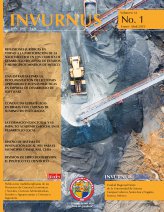Conductas estratégicas en firmas con cadenas de suministro integradas
DOI:
https://doi.org/10.46588/invurnus.v14i1.19Palabras clave:
Cadena de suministro, mercado, redes interconectadas, conductas estratégicas, desempeñoResumen
Las demandas de los consumidores exigen en los mercados respuestas eficientes, eficaces y flexibles, de ahí que para las firmas que participan en éstos el funcionar como entidades aisladas puede representar una limitante para competir. En este contexto, algunas firmas se ven forzadas a emprender estrategias de integración y se interconectan con otras firmas formando una red que incluye proveedores y clientes, donde las organizaciones cooperan para sostener o mejorar su posición competitiva. Este trabajo relaciona el enfoque de cadenas de suministro con el paradigma Estructura-Conducta-Desempeño de la teoría de la organización industrial, para proponer una herramienta de análisis de las conductas estratégicas que adoptan las firmas que se integran en cadena de suministro.
Descargas
Citas
Bain J. (1956). Barriers to new competition. Harvard University Press, Cambridge, Massachusetts.
Cabral, L. M. B. (1997). Economía industrial. McGraw-Hill.
Centikaya, B., R. Cuthbertson, G. Ewer, T. Klaas-Wissing, W. Piotrowicz, y C. Tyssen ( 2011). Sustainable Supply Chain Management. Practical Ideas for Moving Towards Best Practice. Springer.
Chi, T., P.P.D. Kilduff, y V.B. Gargeya (2009). Alignment between business environment characteristics, competitive priorities, supply chain structures, and firm business performance. International Journal of Productivity and Performance Management, 58(7), pp. 645–669.
Chopra, S. y P. Meindl (2010). Supply chain management: Strategy, planning, and operation. 4th ed. Pearson, London.
Christopher, M. (1992). Logistic and Supply Chain Management Strategies for Reducing Cost and Improving Services. 1st. Pitman Publishing. London.
Christopher, M.G. (2000). The agile supply chain: competing in volatile markets. Industrial Marketing Management, 29, pp. 37-44.
Christopher, M. y B. Gaudenzi (2015). Achieving supply chain ‘Leagility’ through a project management orientation. International Journal of Logistics Research and Applications: A Leading Journal of Supply Chain Management. Publicado en Linea.
Cohen, S. y J. Roussel (2005). Strategic supply chain management: The five disciplines for top performance. McGraw-Hill, London.
Corbett, C., J.D. Blackburn, L. Van Wassenhove (1999). Partnerships to improve supply chains. Sloan Management Review, 40, pp. 71-82.
Cousins, P.D. y B. Lawson (2007). Sourcing strategy, supplier relationships and firm performance: An empirical investigations of UK organizations. British Journal of Management, 18, pp. 123-137.
Cousins, P.D. y B. Menguc (2006). The implications of socialization and integration in supply chain management. Journal of Operations Management, 24, pp. 604-620.
Cravens, D.W., N.F. Piercy, y S.H. Shipp (1996). New organizational forms for competing in highly dynamic environments: the network paradigm. British Journal of Management, 7, pp. 203-218.
Das, A., R. Narasimhan, y S. Talluri (2006). Supplier integration – finding an optimal configuration. Journal of Operations Management. 24, pp. 563-582.
Defee C. C. y T.P. Stank (2005). Applying the strategy-structureperformance paradigm to the supply chain environment. International Journal of Logistics Management, 16(1), pp. 28–50.
Evans, R. y A. Danks (1998). Strategic supply chain management: Creating shareholder value by aligning supply chain strategy with business strategy. En: Strategic supply chain alignment: Best practice in supply chain management. Gattorna, J. L. (1998). ed, Aldershot: Gower, pp. 18–35.
Ferguson, P. y G. Ferguson (1994). Industrial Economics. NYU Press. A través de UK Essays, 2013.
Geimer, H. y T. Becker (2001). Supply Chain-Strategien. En Supply Chain Management: Konzepte, Erfahrungsberichte und Strategien auf dem Weg zu digitalen Wertschöpfungsnetzen, Lawrenz, O., K. Hildebrand, M. Nenninger, and T. Hillek, Eds, Braunschweig/Wiesbaden: Vieweg, 2001, pp. 19–37.
Gattorna, J.L. (1998). Ed, Strategic supply chain alignment: Best practice in supply chain management. Ed. Aldershot: Gower.
Gold, S., S. Seuring, y P. Beske (2010). Sustainable Supply Chain Management and Inter-Organizational Resources: A Literature Review. Corporate Social Responsibility and Environmental Management. 17(4), pp. 230–245.
Harland, C. (1996). Supply Chain Management: Relationships, Chains and Networks. British Journal of Management, 7 (Special Issue), pp. 63-80.
Jones, A. y B. Sufrin (2011). EU Competition Law. OUP Oxford. A través de UK Essays, 2013.
Kohlberger, R., C. Engelhardt-Nowitzki, y M. Gerschberger (2012). Supply Chain Strategy – Necessity of a structured method of deduction. International Conference on Economics, Business and Marketing Management. IPEDR, 29, ACSIT Press, Singapore.
Kristal, M.M., X. Huang, y R.G. Schroeder (2010). The effect of quality management on mass customization capability. International Journal of Operations & Production Management, 30, pp. 900-922.
Lambert, D.M. y M.C. Cooper (2000). Issues in supply chain management. Industrial Marketing Management 29, pp. 65–83.
Lee, H.L. (2004). The triple-A supply chain. Harvard Business Review, 82, pp.102-113.
Lummus, R.R. y S.M. Demarie (2006). Evolutionary chain. Industrial Engineer: IE, 38(6), pp. 38–42.
Martin, S. (1993). Advanced industrial economics. Blackwell Publishers. Cambridge, Massachusetts.
Mentzer, J.T., W. DeWitt, J.S. Keebler, S. Min, N.W. Nix, C.D. Smith, y Z.G. Zacharia (2001). Defining Supply Chain Management. Journal of Business Logistics, 22(2), pp.1–25.
Netessine, S. (2007). Supply Chain Networks. The Wharton School. University of Pennsylvania.
Phillips, A. (1974). Comentario. En: Industrial concentration: The new learning. Goldschmid, H., H.M. Mann, y F. Weston, Boston, Ma. Little, Brown, 408-13. A través de Martin, S. (1993). Advanced industrial economics. Blackwell Publishers. Cambridge, Massachusetts.
Qi, Y., X. Zhao, y C. Sheu (2011). The impact of competitive strategy and supply chain strategy on business performance: the role of environmental uncertainty. Decision Sciences Journal, 42, pp. 371-389.
Ramirez, J.C. y K. Unger (1997). Las grandes industrias ante la restructuración: una evaluación de las estrategias competitivas de las empresas líderes en México. Foro Internacional, 37(2), pp. 293-319.
Sarkis, J., Q. Zhu, y K. Lai, (2011). An organizational theoretic review of green supply chain management literature. International Journal of Production Economics, 130(1), pp. 1-15.
Sennheiser, A. y M. Schnetzler (2008). Wertorientiertes Supply Chain Management: Strategien zur Mehrung und Messung des Unternehmenswertes durch SCM. Heidelberg: Springer. A través de Kohlberger, R., C. Engelhardt-Nowitzki,y M. Gerschberge, M. (2012). Supply Chain Strategy – Necessity of a structured method of deduction. International Conference on Economics, Business and Marketing Management. IPEDR, 29, IACSIT Press, Singapore
Shepherd W. (1999). The Economics of Industrial Organization. Prentice-Hall. University of Michigan.
Slack, N., S. Chambers, C. Harland, A. Harrison, y R. Johnston (1998). Operations Management. 2nd. ed. (Pitman Publishing), Financial Times, London.
Stigler, G. (1983). The Organization of Industry. Chicago: University of Chicago Press.
Stuart, F.I. (1997). Supply-chain strategy: Organizational influence through supplier Alliances. British Journal of Management, 8, pp. 223-236.
Tirole, J. (1995). The Theory of Industrial Organization. The MIT Press, Cambridge, Massachusetts.
Thun, J. (2005). The Potential of Cooperative Game Theory for Supply Chain Management. En: Reseach methodologies in Supply Chain Managements. In Collaboration with Magnus Westhaus. Springer Link. pp. 477-491
UK Essays (2013). The Structure Conduct Performance Framework in Industrial Organizations Economics Essay. http://www.ukessays.com/essays/economics/the-structureconduct-performance-framework-in-industrialorganizations-economics-essay.php [Recuperado el 24 de Septiembre, 2015].
Walters, D. y G. Lancaster (2000). Implementing value strategy through the value chain. Management Decision, 38(3), pp.160-178.
Yeung, A.C.L. (2008). Strategic supply management, quality initiatives, and organizational performance. Journal of Operations Management, 26, pp. 490-502.













